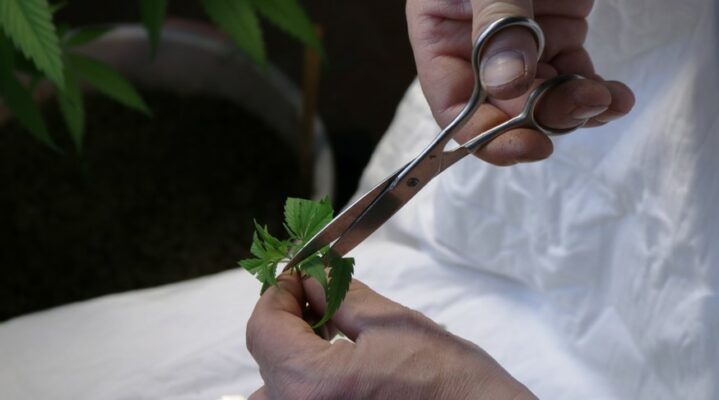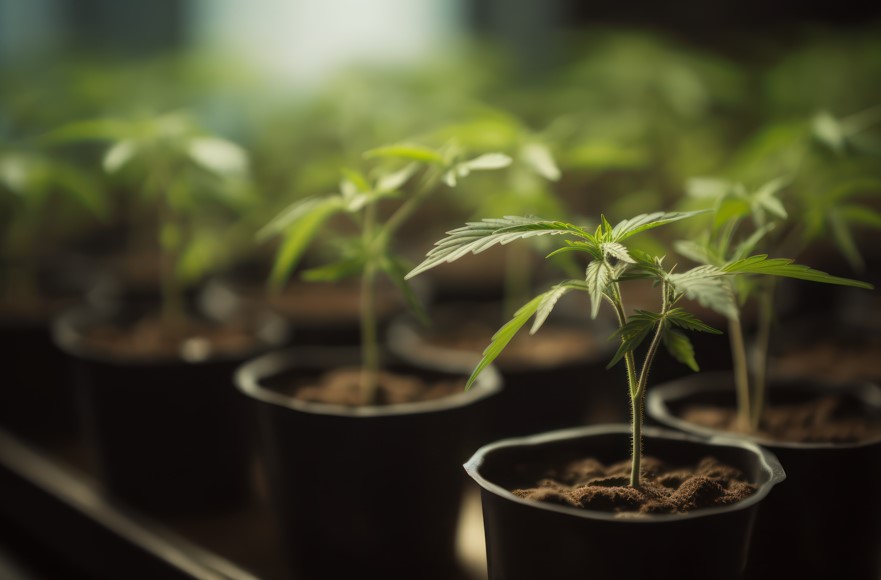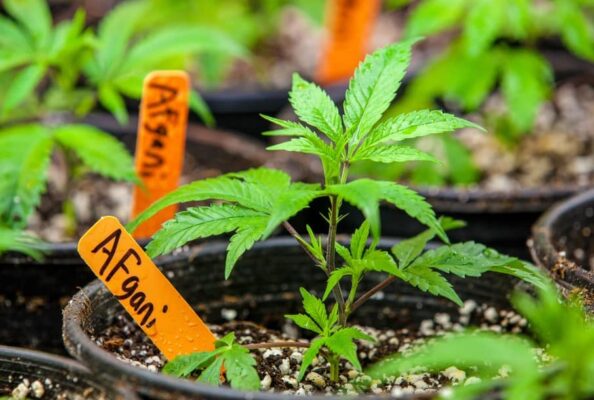Marijuana
Cloning Weed: The Ultimate Guide
Managing your own cannabis grow operation, regardless of its size, comes with a variety of obstacles and challenges that you need to overcome in order to get the most out of your investment. One of such challenges is ensuring a steady, consistent supply of high-quality plants for the future. Whether you’re growing weed for personal use or with the purpose of selling it, you need to figure out a way to maintain a high level of quality of your plants with each harvest cycle.
One of the best ways to ensure that your grow op will deliver consistently good yields is cloning marijuana plants. In a nutshell, it entails creating identical copies of your original plant with the same traits, THC levels, and all the good stuff that makes it stand out. In this comprehensive guide, we’ll take you through all of the intricacies of cloning cannabis. By the time you’re done reading, you should have a clear idea of how to get started and get the most out of the process.
What Are Clone Weed Plants?
Every cannabis clone starts with a cutting of a live plant. A cutting is typically a branch of a healthy marijuana plant that will grow into its own herb, all the while preserving the same traits and qualities of its source material. After taking your cutting off the mother plant, you’ll need to place it in a medium and feed it hormones to promote growth. We’ll get into the specific mediums and how to choose the right one for your operation later on in this guide.
Once your cutting develops roots, it needs to be transplanted into the ground or a pot, where it will continue growing just like a regular cannabis plant that emerged from a seed. Cloning is one of the main methods used by commercial marijuana growers, as it helps them ensure a consistent output of their top-performing strains, saving a lot of money and space in the process.
Mother Plants
Without a mother plant, cloning is simply impossible. When talking about mother plants, we refer to the cannabis plant that serves as a source of your cuttings. Selecting the mother plant is the very first step of the cloning process; you need to choose a specimen that is strong and healthy. After all, if you cut off a sickly or otherwise damaged plant, all of its clones will also turn out subpar.
Make sure that your mother plant is in the vegetative stage when you clip the cuttings off of it. A cannabis plant usually enters the vegetative stage after two to three weeks of planting and remains in it for anywhere between two to sixteen weeks, depending on the strain and growing conditions. In order to get the best possible cuttings, you might want to give your plant about a week in the vegetative stage before you start clipping in order to get the sturdiest, healthiest branches possible.
There are two approaches you can take up when it comes to maintaining a steady supply of cuttings for your grow op. One of them is carefully maintaining your original mother plant and keeping it in the vegetative stage, preventing it from entering the flowering phase indefinitely to keep getting the branches you want. However, this requires a lot of resources and effort, and is generally not recommended for beginner growers. The other one is simply selecting one of your clones to be the “next” mother plant, sourcing the further cuttings from it, and repeating the cycle. If you do everything right, then the clones will retain the exact same properties as the original plant, so the fact that you’re “cloning a clone” doesn’t really come into play here.
What Makes a Good Mother Plant?
As we briefly mentioned earlier, it’s not enough to just take any weed plant you have growing in your backyard or growbox and turn it into your designated mother plant. It needs to meet a specific set of criteria, such as:
- Pest and mold resistance
- Large yield capacity
- High trichome density
- Strong flavor and aroma
You should also observe your potential mother plant to see if it grows well, i.e. creates sturdy branches and has a consistent growth pace. If you find the optimal candidate, it will let you obtain an abundance of top-quality buds without the risk of having a botched batch (provided that you tend to your plants in the right way).
The Benefits of Cloning Marijuana
There are a couple of reasons why growers stand by cloning their plants to achieve consistent, uninterrupted output. Here are just a few of the major ones:
- Cloning ensures that all your plants are female. That saves you a lot of time early on in the growing process by letting you avoid the germination and early seedling stages, as well as things like sexing your plants and discarding male specimens.
- Consistent output. With cloning, all of your subsequent plants will have the exact same qualities as their mother plant. If you’re a commercial grower, this is a key aspect of your business’s success, as buyers look for suppliers they can rely on for high-quality buds week in, week out. If you’re growing for personal use and find a strain you took a particular liking to, then cloning is a way to have a potentially infinite supply of that strain.
- Cloning saves you money. Buying seeds can get expensive, especially if you factor in the fact that some of them will fail to break out, grow into male plants, or get sickly in the seedling stage. Feminized seeds ensure that you’ll get a female plant, but they’re significantly more expensive than regular ones and are still susceptible to the risk we just mentioned.
How to Clone Cannabis

With the basics out of the way, you can now dive straight into learning all about the process of cloning cannabis itself. We need to start this section with a quick disclaimer, though: while growers clone weed with the purpose of obtaining genetically identical plants, there are no 100% guarantees in the world of horticulture. Changes in your grow site, setup, or unexpected weather events (if you grow outdoors) can result in your clones developing characteristics that make them slightly different from the mother plant. This is why it’s important to remember that cloning is not a “set-it-and-forget-it” way of growing weed. Your clones require the same kind of care and attention as all of your other plants.
What You’ll Need
In order to begin cloning weed, you’ll need certain equipment. Thankfully, as a grower, you probably already have most of it at hand. Here’s what you’ll need to successfully get your cuttings and root them:
- Scissors. Good gardening scissors are necessary for cutting the branches off your mother plant.
- Razor. You’ll need a razor to trim your cuttings and get them ready to be planted into your rooting medium.
- Rooting hormone. These come in many shapes and forms, such as powder, liquid, or gel. Powder hormone is preferred by commercial growers, as you can cover large surfaces with it, whereas liquid and gel formulations are preferred by those growing weed at home.
- Rooting setup. This is where things get a bit more complicated. The optimal setup will vary depending on the grower’s budget and the size of their grow operation. We’ll take you through the available options later on in the guide.
Taking a Cutting
Cutting a branch off the mother plant sounds easy enough, but if you’re not careful enough or select the wrong part of the plant, you’re running the risk of botching your clones right at the start. Pay attention to the following:
- Branch length and health. You want a healthy, sturdy, and long-enough branch that’s ready to take root and grow into a beautiful cannabis plant. Find a branch with at least two nodes on it.
- Cut carefully. You should place your cut right above the node that your chosen branch sprung out of.
- Increase the rooting surface area. With a razor, shave off the bits below your branch’s bottom node at a 45-degree angle. This will ensure that the cutting will take root as fast as possible.
- Hormone dipping. Timing becomes crucial once you separate your cutting from the mother plant. Place it in the rooting hormone right after increasing the rooting surface area, and then transfer it into your rooting medium immediately.
Rooting Medium & Setup
The key part of the cannabis cloning process is getting your cuttings to take root. In order to achieve that, they’ll need to be planted in the right rooting medium, where they’ll receive the rooting hormone and unrestricted access to plenty of light throughout the day. While you can risk putting your cuttings directly into the soil, we recommend against this, as they are extremely delicate and sensitive at the start, requiring plenty of stability, which is quite hard to come by in loose soil.
There are plenty of rooting mediums you can try out, such as delicate foam or peat, but rockwool and water are recommended by most experienced growers, which is why we’ll focus on them in this part of our guide.
Rockwool
Rockwool is obtained by spinning melted rock into fine threads that are malleable, providing plenty of stability and protection for your cuttings. They also allow for great airflow and retain moisture quite well, making them the preferred rooting medium for weed growers, especially ones that are just starting out. You can buy rockwool cubes in bulk at affordable prices to make sure that you have plenty of the stuff for your current and future clones.
To root your cuttings in rockwool, you simply need to dip them in rooting hormone and carefully place them in the rockwool cube. Then, transfer the cubes into a water-filled tray and cover them up with a dome to retain maximum moisture. Once you see the roots popping up, you can safely transplant your plants into the soil.
Water
Cloning in water is even simpler than doing it in rockwool. All you need for a single cutting is a paper cup filled with water. Once you dip the branch in rooting hormone and place it in the cup, do the same for the rest of your cuttings and place them on a tray. Then, cover it up with a transparent dome to maintain the right humidity levels and wait for them to root. Once they do, transplant them into a soil-filled pot or plant them outside.
Buying Clones: Is It Worth It?
Although the cloning process is simple enough to do by yourself, and we encourage all growers to try it out for themselves at least once, sometimes you just don’t have the time and resources to have a go at it. If you’re not planning to start a long-term grow operation and just want to quickly spring up a few plants for personal use, buying clones at a dispensary or a dedicated growers’ store might be the solution you’re looking for. You’ll still save a lot of time, and you can use one of the clones you buy as a mother plant for any subsequent plants. Just be prepared to pay a little extra for the convenience!
What to Look Out For When Buying Clones
Not all clones are created equal. Depending on the conditions at each particular store and their level of expertise, you might run into vendors with subpar quality cuttings in their inventory. Here’s what to watch out for when shopping for store-bought clones:
- Stem. Look for a wide, sturdy stem. Thin and bendy ones were likely taken off a sickly or immature mother plant and are likely to fail to take root.
- Pests. Make sure to inspect the cutting and its medium for any signs of pest contamination. You won’t be able to spot all possible pests, but things like webbing from spider mites or insect bite marks are usually clearly visible. If you notice any worrying signs, steer clear of that cutting.
- Disease signs. You might not be an expert in plant health, but some disease signs are pretty easy to spot. Discoloration, irregular growth (possible sign of mutation), or limping leaves are dead giveaways that there’s something wrong with a specimen. Be particularly cautious of buying a cutting with white powder on the stem or leaves; these can be signs of mildew, which can easily transfer to other, healthy plants, potentially ruining your entire batch.
Once you buy some promising cuttings, make sure to clean them thoroughly and initially plant them away from your other plants for a quarantine period of up to one week. This will ensure that all your other plants stay safe should the cutting have any pests or diseases that you couldn’t spot back at the store.
Final Thoughts
Do you want to have a fruitful grow operation that puts out plenty of high-quality weed plants with delicious, potent buds? Cannabis cloning is a great way to go about achieving this goal. Once you have a grasp of the basics of weed growing, you can easily start cloning your plants, even as a relative newbie. After some time, you’ll have a self-sufficient, reliable supply of weed for many plant generations to come!
If you’re unsure of where to get started as a brand-new grower, check out the Get Kush store. We sell high-quality seeds that can give rise to top-notch mother plants you can base your cloning process around, as well as some of the best flowers around for you to have something to smoke as you wait for your plants to be ready for harvest.



